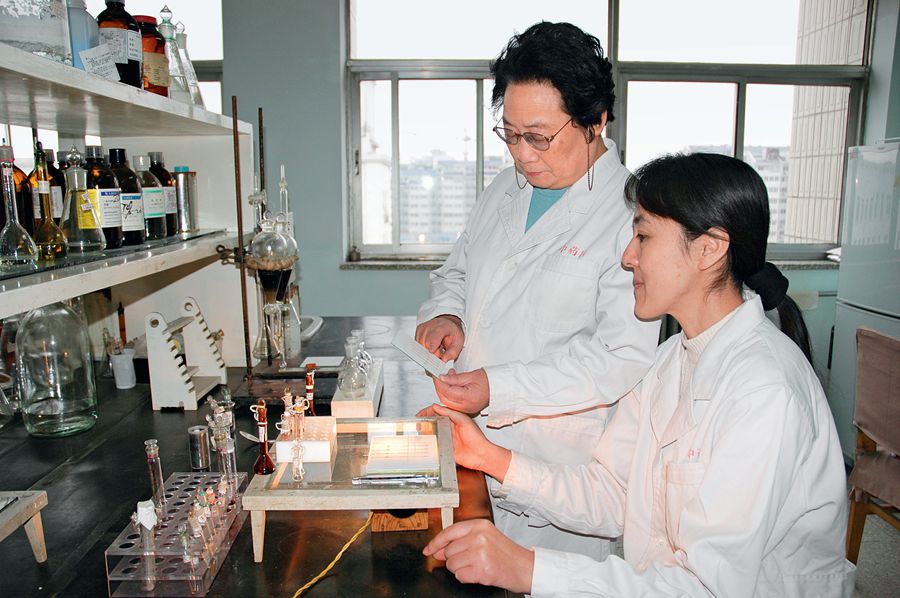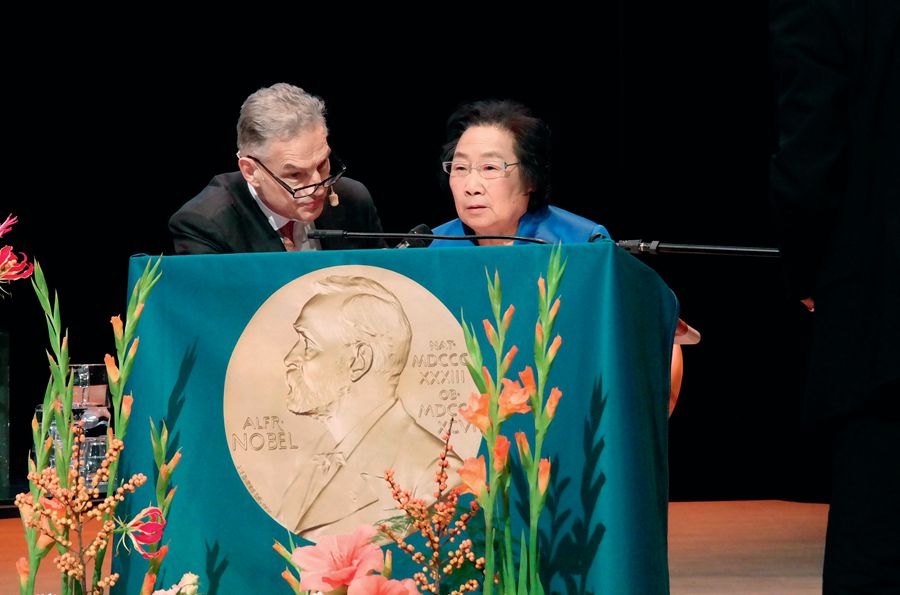ON June 17, 2019, a piece of blockbuster news quickly topped the search list of hot topics. After many years of hard work, Tu Youyou’s team proposed a new treatment plan for dealing with the problem of “drug resistance” of artemisinin in Southeast Asia. As a result of their research, they found that artemisinin has the effect of treating lupus erythematosus. The discovery has been highly recognized by the World Health Organization (WHO) and authoritative experts at home and abroad.
Earlier this month, the British Broadcasting Corporation (BBC) launched a campaign to vote for “the Greatest Person of the 20th Century.” Tu, China’s first Nobel Prize winner in physiology or medicine, successfully entered the list of 28 candidates and was the only Asian among the candidates. The campaign created a special introduction page for each candidate. On the page of Tu, the BBC listed three reasons for selecting her: she still holds scientific ideals in difficult times; she keeps moving forward while never forgetting to learn from the past; her achievements influence both the West and East. The introduction of Tu in the “ICONS” column is as follows: Pharmaceutical chemist whose research helped save millions of lives. Inspired by ancient books, Chinese chemist Tu Youyou discovered a new treatment for malaria, which has helped save lives globally.
Discovery of Artemisinin
Tu was born at the end of 1930 in Ningbo, east China’s Zhejiang Province. In 1951, she was admitted to the School of Pharmaceutical Sciences, Peking University, where she studied the major of pharmacognosy and had a strong interest in phytochemistry and herbalism. Ever since she stepped into this field, she has worked closely with the development and application of natural drugs. After graduation in 1955, she joined the Institute of Chinese Materia Medica of the Academy of Traditional Chinese Medicine, which is the present China Academy of Chinese Medical Sciences. During this period, she also took time off from work to study Chinese medicine for two years.

Tu Youyou and her colleague work in the lab.
In the 1960s, as many people around the world were suffering from malaria, Tu, having a background in Chinese and Western medicine, and hard-working spirit, accepted the anti-malaria research task assigned to her from the Office of the National Research Project for Malaria Prevention and Control. In 1969, at the age of 39, Tu became the head of the research team focusing on curing malaria with traditional Chinese medicine (TCM) and began the difficult process of conquering the endemic.
Reading TCM books, visiting famous veteran doctors, and consulting prescriptions donated by the public made up a typical day for Tu. Within just three months, she had collected more than 2,000 prescriptions of traditional Chinese pharmacology including plants, animals, and minerals. On this basis, she compiled more than 640 prescriptions of TCM for treating malaria.
Since then, Tu Youyou has taken antifebrile dichroa, pepper, and artemisia apiacea as the main objects of study and conducted focused studies on them. By early September 1971, she and her colleagues had carried out various experiments on more than 100 extractive agents from TCM decoction, including artemisia apiacea, and more than 200 ethanol extractive samples, but the results were frustrating. The highest inhibition rate against plasmodia was only about 40 percent.
Tu, a relentless researcher, turned to medical classics for inspiration. The method worked.
Tu realized that temperature was the key factor in extracting the effective anti-malarial ingredients from herbs. She redesigned a new extraction scheme. Since September 1971, experiments had been carried out night and day on key drugs preciously selected and some backups. The results showed that after removing the acidic part of artemisia apiacea diethyl ether extract, the remaining neutral part had the best efficacy.
On October 4, after hundreds of attempts, a preliminary breakthrough was made. Experiments confirmed that the inhibition rate of artemisia apiacea diethyl ether neutral extract on rodent plasmodium reached 100 percent.
However, obtaining effective samples was only the first step, and clinical trials had to be carried out before massive application could be implemented, which required a large quantity of artemisia apiacea diethyl ether extracts. At that time, no pharmaceutical factory could provide that amount. So the research group had to adopt a difficult method. They moved seven water tanks for domestic use to the laboratory for experiments. The containers were filled with diethyl ether and the artemisia apiacea was immersed in them to extract test samples.
Diethyl ether, as a type of organic solvents, is a harmful chemical. During that period of time, the smell of pungent diethyl ether permeated both the laboratories and the corridors. Working day after day in such an environment, in addition to dizziness, scientific researchers experienced such symptoms as nose bleeds and skin allergies, but no one complained.
During pre-clinical trials, suspected toxic side effects were found in pathological sections of individual animals. Was it a problem with the animal itself, or was it caused by the drugs? In order not to miss the clinical observation season of that year, Tu volunteered to test the drug personally. “I am the group leader, and I have the responsibility to test it.”

On the afternoon of December 7, 2015, Tu Youyou, the Chinese scientist who won the Nobel Prize in Physiology or Medicine in 2015, delivers a keynote speech at the Karolinska Institute in Sweden.
In July 1972, Tu and two other researchers were admitted to Beijing Dongzhimen Hospital as the first volunteers to undergo human trials. After a week’s trial and observation, no obvious toxic side effects were detected. From August to October of that year, Tu took the samples and rushed to the malaria-stricken area in Changjiang Li Autonomous County, south China’s Hai-nan Province. She crossed mountains and rivers in the scorching heat and tested her findings on 21 patients. The results were satisfactory.
The research didn’t stop. Effective artemisinin crystals were obtained in November 1972, and a series of safety tests were completed in the first half of 1973. In autumn of that year, artemisinin capsules were used for the first clinical trial in Hainan. In cooperation with the Institute of Biophysics of the Chinese Academy of Sciences and the Shanghai Institute of Organic Chemistry, the chemical structure of artemisinin was determined at the end of 1975. The results showed that artemisinin was a new drug that has a nitrogen-free structure.
In 1977, with the approval of then Ministry of Health, the research results were published in the Chinese Science Bulletin, declaring the scientific breakthrough to the world. In October 1986, artemisinin was accredited by then Ministry of Health.
In 1992, Tu developed an “upgraded version” of the drug, which increased the efficacy by 10-fold and reduced the cost.
Since 2000, the WHO has promoted artemisinin as the first-choice anti-malarial drug worldwide. In 2010, about 180 million people received artemisinin-based combination therapy worldwide, with a cure rate of 97 percent. The WHO’s World Malaria Report showed that between the year 2000 and 2015, malaria mortality rates among risk groups in all age groups worldwide fell by 60 percent, and that of children under five years of age decreased by 65 percent.
Tackling Drug Resistance
Since Tu discovered the medicine, artemisinin derivatives have been used as the most effective and complication-free combination drug for malaria. However, the latest WHO World Malaria Report released in 2018 showed that there was an estimated 219 million malaria cases that occurred worldwide in 2017, compared with 217 million in the previous year. Plasmodium has developed resistance to artemisinin-based anti-malarial drugs, presenting new challenges to global malaria prevention and treatment.
In order to tackle the problem Tu, now in advanced years, led the team to continue fighting the battle against malaria as China has basically eliminated malaria. Tu believed that clarifying the mechanism of artemisinin was the key to finding the answer.
After more than three years of scientific research, Tu’s team made new breakthroughs. A new treatment method was proposed. First, the medication use should be moderately prolonged from three days to five or seven days. Second, supporting drugs against which resistance has been developed should be replaced. The solution was proved to be effective.
On April 25, 2019, the 12th World Malaria Day, the New England Journal of Medicine, an international authoritative journal, published Tu’s major research results and treatment plan that solved the drug resistance problem. The result drew widespread attention.
The significance is profound. First, it boosted researchers’ confidence in artemisinin and the drug will remain as the first choice in treating malaria for a long time in the future. Second, it helps realize the goal of ending the endemic worldwide. The drugs, which only cost less than US $10 for one course of treatment, are affordable for poor people in the vast region of Africa, a malaria-plagued continent.
A Possible Cure for Lupus Erythematosus
In the process of tackling the drug resistance problem, Tu’s team also found that dihydroartemisinin has a unique effect on highly variable lupus erythematosus. Now, the first phase of clinical trials is underway. “Artemisinin is effective in treating lupus erythematosus, and we are cautiously optimistic about the success of the experiment,” Tu said. “We hope that artemisinin can make greater contribution to all mankind.”
Lupus erythematosus is a typical autoimmune connective tissue disease. The current treatment available is medication with immunosuppressive agents, which is unable to cure the disease but has the risk of subsequent infection. According to preliminary clinical observations of Tu’s team, the efficacy rate of artemisinin in treating discoid and systemic lupus erythematosus is over 90 percent and 80 percent respectively.
The application for clinical trial of dihydroartemisinin in treating discoid and systemic lupus erythematosus has been approved by China’s National Medical Products Administration. Under the guidance of Tu’s team, phase I of the clinical trial was officially launched in May 2018, with 120 design samples, and 15 organizations including Peking Union Medical College Hospital and Peking University First Hospital participating in the project. About 500 Chinese and foreign patients enrolled in the clinical trial, which has been carried out.
Tu said, “The clinical trials generally include three phases. The second and third phases demand a larger number of samples, and will take at least seven to eight years. If they are successful, the new dihydroartemisinin tablets are expected to be approved for sale as early as the year 2026.”

